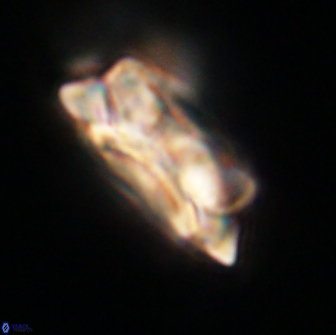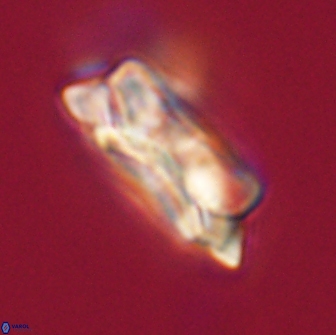Noelia uenverdii
Noelia uenverdii Varol, 2023
A large (8.0–12.0 μm), circular species of Noelia consisting of a non-birefringent lenticular distal shield, an appressed proximal shield, and a broad distally protruding tube cycle with a central opening.
In honour of Mr Murat Ünverdi, Geologist, Izmir, Turkey.
The diameter of the distal shield: 10.65 μm (measured in plan view in phase-contrast), the diameter of the proximal shield: 6.60 μm (measured in side view in cross-polarised light), the diameter of the tube cycle: 8.40 μm (measured in plan view in phase-contrast), the maximum height of the distal shield and tube cycle: 3.96 μm (measured in side view in cross-polarised light), the free length of the tube cycle: 1.67 μm (measured in side view in cross-polarised light), the diameter of the central opening: 1.79 μm (measured in plan view in the bright-field).
The size and the shape of the central opening vary from circular to elliptical and are considered to be modified by adverse preservational conditions. The distal shield and the tube cycle are constructed of a similar number of segments (about 30–50). The number of segments in the tube cycle can be counted in a bright-field setting and in cross-polarised light with a gypsum plate (Plate 15, Figs. 16, 20, 22, 24 in Varol, 2023). The tube cycle and the proximal shield create an asymmetrical X-shape structure in side view (Pl. 13, Figs. 10, 14 in Varol, 2023). The diameter of the tube cycle is always greater than the width of the shield, and it is distinctly protruding above the distal shield. There is a distinct depression at the distal end of the tube cycle. The narrowest point of the central area lies at the boundary between the tube cycle and the proximal shield and corresponds to the sharp tapering inner end of the distal shield.
In cross-polarised light, when using the gypsum plate, blue regions correspond to the horizontal axis on the distal side (Pl 13, Fig. 18 in Varol, 2023). In contrast, the blue sectors correspond to the vertical axis on the proximal side (Pl. 13, Fig. 20 in Varol, 2023).
Noelia uenverdii differs from Noelia mahaniae by being circular rather than subcircular with an elliptical central area. Noelia uenverdii is differentiated from Noelia kolona by having a central opening, whilst the latter lacks any central opening. Noelia uenverdii differs from Senelia, Carlamuelleria, Markalius and Davidbukrya by the presence of a distinctly protruding tube cycle above the distal shield and a central opening. The tube cycle is flush with the distal shield in Senelia, Markalius and Davidbukrya. Moreover, Noelia uenverdii is further distinguished from Davidbukrya and Carlamuelleria by having an appressed proximal shield. Markalius has a spaced proximal shield with an acute angle of inclination. In contrast, Carlamuelleria and Davidbukrya have a vestigial diminutive or no proximal shield, respectively.
Varol, O. 2023. New paleocene calcareous nannofossils: Carlamuelleria, Davidbukrya, Mauriceblackia, Noelia and Senelia. Marine Micropaleontology. 180: 1-41.



